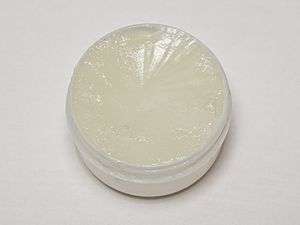Moisturizer

Emollients are cosmetic preparations used for protecting, moisturizing, and lubricating the skin. These functions are normally performed by sebum produced by healthy skin. The word "emollient" is derived from the Latin verb mollire, to soften.
Description
Water constantly evaporates from the deeper layers of the skin, an effect known as transepidermal water loss (TEWL). By regulating its water content, skin maintains a dry, easily shed surface as a barrier against pathogens, dirt, or damage, while protecting itself from drying out and becoming brittle and rigid. The ability to retain moisture depends on the lipid bilayer between the corneocytes.[1]
Emollients prevent evaporation of water from the skin by forming an occlusive coating on the surface of the stratum corneum. TEWL is normally about 4–8 g/(m²⋅h). A layer of petrolatum applied to normal skin can reduce the TEWL by 50–75% for several hours.
Humectants also have an emollient effect, but they act differently, by drawing water into the stratum corneum.
The more lipid in the formulation, the greater the emollient effect. Ointments are more emollient than oily creams which are more so than aqueous creams, while most lotions have no emollient effect.
Kinds
Emollients are available as creams, ointments, bath oils, or soap substitutes.
Petrolatum (White Soft Paraffin) is probably the most effective emollient. Other popular emollients are castor oil, cetyl alcohol, cetearyl alcohol, cocoa butter, isopropyl myristate, isopropyl palmitate, lanolin, liquid paraffin, polyethylene glycols, shea butter, silicone oils, stearic acid, and stearyl alcohol.
Mineral oils and waxes are insensitive to oxidation or rancidity. For this reason, they have essentially replaced vegetable oils in emollients and topical medication.
Emollient cosmetics may additionally contain antioxidants, ceramides, emulsifiers, fragrances, humectants, penetration enhancers, preservatives, and solvents. Some products are marketed as having anti-wrinkle and skin enhancement effects. Many plant and animal extracts have been claimed to impart skin benefits, with little scientific evidence.
History
Although various lipids or emollients have been used for anointing throughout history, this use hardly counts as cosmetical in today's sense. Scientific cosmetic chemistry exists only since 1920.
Use
Emollients are used for the treatment of certain skin ailments, such as psoriasis, ichthyosis vulgaris, xerosis, and pruritus in atopic dermatitis. More often, they are bases or vehicles for topical medication, such as in Whitfield's ointment. They are often combined with keratolytic agents, such as salicylic acid and urea.[2]
Emollients are also widely used in sunscreens, antiperspirants, skin cleansers, shaving creams, aftershaves, and hair tonics.
Emollients are used in disposable napkins to prevent dry skin and napkin dermatitis. However, a Cochrane review found their use was associated with increased bacterial infection.
Emollients are used to protect against frostbite, at least in Finland. However, those who use them experience more frostbite.
Excess use of emollient may cause mild folliculitis, especially in adolescent girls. It may also exacerbate fungal skin infection (dermatophytosis). Subcutaneous injection of emollient may cause panniculitis.
Emollients should be used after bathing or daily.